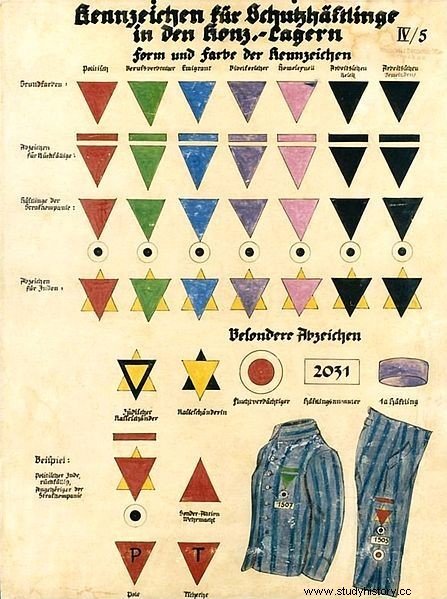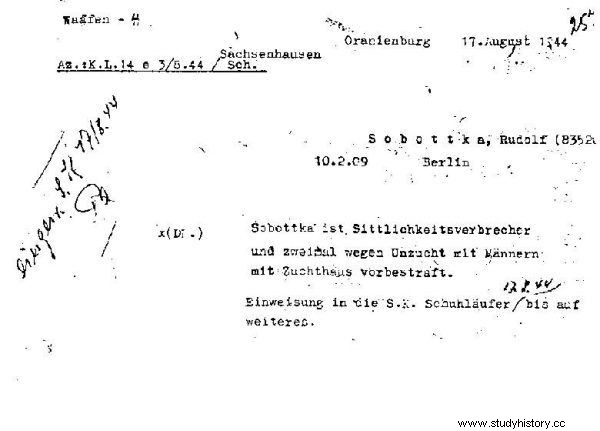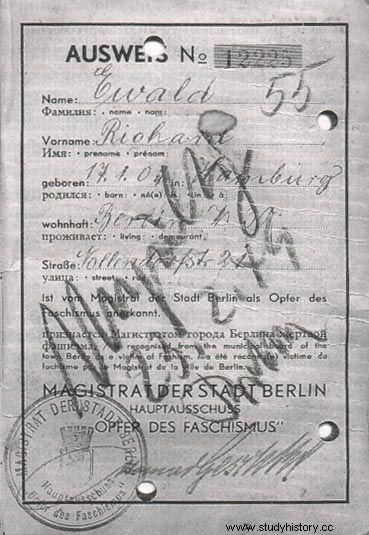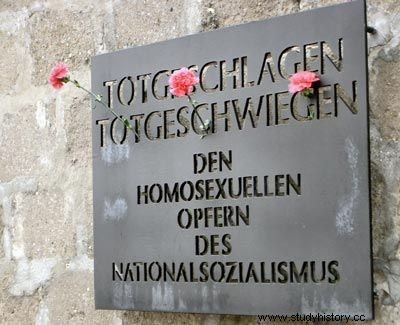The deportation of homosexuals, an issue both historically and politically, aroused interest in the late 1970s due to the struggle for the rights of gays and lesbians. This issue was reflected in a number of studies introducing the topic and in elaborations on the number of victims and the place of their extermination.
The spread of HIV and AIDS in the 1980s spurred historical research into a social group that was long forgotten about persecution. At the height of this crisis, the memory of the deportation of homosexuals was a media challenge, some saw the epidemic as a form of extermination similar to that of World War II. It was at that time that the term "homo Holocaust" appeared signifying the Holocaust of homosexuals between 1933 and 1945. Some authors and defenders of homosexuality, including Guy Hocquenghem, argued that up to one million homosexuals from all over Europe were deported to concentration camps for extermination.

The article is an excerpt from the book Myths of World War II part 2 Poznań Publishing House
This claim is nothing new because, right after the start of World War II, some activists believed that the Soviet Union, like Nazi Germany, was preparing to eliminate European homosexuals. Historical research on the persecution of homosexuals in the Soviet Union contains many gaps, but we know much more about the Nazi regime. Two false views should therefore be rejected immediately - that homosexuality was not the subject of either a policy of extermination or genocide ; only in Pan-German territory has the homosexuality of men, and to a much lesser extent of women, been criminalized.
Outline of the situation
Although the unique regulations targeting homosexuals were promulgated and implemented simultaneously with other laws directed against the political opponents of Nazism (communists, democrats, clergy, Jehovah's witnesses) and against Jews who were deported to concentration camps from 1942 and systematically were exterminated, however, unlike the Jews who were deported to concentration camps from all over Europe, the persecution of homosexuals mainly concerned German citizens and the population considered by the Nazi regime to be Volksdeuts that is, ethnic Germans or Germans from countries whose population was Aryan.
According to the estimates available today, more than 50,000 convictions for homosexuality were handed down in Germany between 1933 and 1945 and that between 5,000 and 10,000 homosexuals were imprisoned in concentration camps. In addition, several dozen lesbians were also placed there.

Nazi instruction board. A pink triangle marked the men placed there for homosexuality in the concentration camps. The black triangle was reserved for women showing anti-social attitudes, i.e. for lesbians.
This marked difference was due to Article 175 of the German Criminal Code, which allowed for the arrest and sentencing of a homosexual, but only applied to men. This distinction was also apparent in the concentration camps, as only the men had to wear a red triangle over their camp clothing, indicating that their homosexuality was the cause of their imprisonment . This emphasis on abnormal sexual orientation put them in a difficult position among prisoners who were in concentration camps for other reasons. Moreover, in some cases, as was the case in the Buchenwald concentration camp, homosexuals were forced to undergo hormone therapy (led by a Danish doctor - Carl Vaernet) and even castrated.
Since homosexuals were assigned the hardest jobs and marginalized by other prisoners, few of them survived the concentration camps. This allows us to understand why only very few homosexuals have agreed to bear testimony of the suffering they have endured.
Persecution of German homosexuals
After Hitler came to power, the Nazi persecution began with a series of repressions leading to the prohibition of all publications and the dissolution of homosexual organizations and associations that had previously flourished in Germany. After the murder in June 1934 of Ernest Röhm, the SA commander known for his homosexuality, the Gestapo began compiling lists of people known to the police for their sexual inclinations.
There have been numerous arrests and numerous indictments under section 175 of the German Criminal Code for "unnatural sex" between consenting men. At the same time, in December 1934, the police began to conduct raids in large cities on bars and cafes where homosexuals met.
A year later, Article 175 was made even more stringent. As of June 28, 1935, any sexual act between two men was punishable. At this point, not only anal intercourse was punishable as "against nature" sex, but also any sexual activity between two consenting men. There was an increasing number of convictions under this section.
From 1936, the persecution began to intensify due to the restructuring of the judicial police ordered by Heinrich Himmler and the creation of the Reichszentrale zur Bekämpfung der Homosexualität und Abtreibung, the Reich Office to Combat Homosexuality and Termination of Pregnancy, located in Berlin. Himmler and Nazi ideologues believed that homosexuality and the practices of termination of pregnancy were a direct threat to birth rate. At the same time, the Nazi newspapers Der Stürmer and Das Schwarze Korps were in the service of this demonic campaign. The arrest of Leopold Ogermayer in 1936 was therefore used to show the threat of a Jewish and homosexual conspiracy that was to threaten the Third Reich.

Admission card for a homosexual prisoner, Rudolf Sobbotka, to the concentration camp in Sachsenhausen.
The Das Schwarze Korps newspaper, in its issue of March 4, 1937, called on all Germans to denounce homosexuals. From that moment on, not only the police were to be vigilant, but the whole society should mobilize itself in the fight against homosexuality.
Nevertheless, it did happen from time to time that propaganda, which was hostile to homosexuality, led to undesirable outcomes. The protests that followed the arrest of the famous dancer and choreographer Alexander von Swaine and the fact that there were many artists among men detained for homosexuality resulted in Himmler introducing derogation laws for artists and actors arrested under article 175 under the ordinance of October 29, 1937:
The Reichsführer SS and German Police Commander introduces a regulation that any arrest of an artist or actor for unnatural sexual acts requires prior authorization, unless the person is caught red-handed.
After the outbreak of the war, the situation of homosexuals in Germany worsened even more. The decree issued by Himmler on July 12, 1940, aimed at combating crime, permitted the placing of suspects in concentration camps without a court sentence. Since then, "every man who has seduced at least one partner" has been systematically sent to concentration camps. Later, other decrees were issued, including the one on "declaration of hostile activity against the nation and the state" of April 2, 1941, which allowed the expropriation of any person convicted under section 175 of the Criminal Code.
After all, in 1942 a Reichsmarschall decree by Hermann Göring called for a distinction between "notorious seducers" and "seduced". The former were sentenced to prison terms, and then, after serving them, were sent to concentration camps, while the latter, after serving their sentence, were "tested" at the front. These steps were therefore aimed, in fine, at acquiring additional manpower for work in concentration camps and recruiting homosexuals into the army at a key moment of the war, when the Germans fought simultaneously on the Eastern and Western fronts.
Nazi legislation extended to annexed territories
These procedures were successively spread over the territories annexed by the Third Reich:starting with Austria (1938), which already had provisions for homosexuality in its penal code, then the Sudetenland (1938), and ending with Alsace-Mosel (1940) and The Netherlands, occupied from 1940. In Austria, articles 129 and 130 of the Criminal Code condemning homosexuality had been in force since 1852. Affected both men and women. In 1940, Austrian homosexuality convictions were brought into line with Article 175 of the German Criminal Code, in the tightened version of 1935. Anszlus thus maintained and tightened legislation that penalized homosexuality in both men and women.
As for the annexed Sudetes and Alsace-Moselle, the authorities of the Third Reich implemented quite specific regulations:they sanctioned the retroactive effect of article 175, which allowed homosexuals to be sentenced to greater penalties, taking into account the acts they had committed even before the annexation. Thus, the Strasbourg court made use of the retroactive rule of Article 175, which came into force in 1942, in several of its cases before it.

Invalidated ID card granting the rights of a "victim of fascism" to a former camp prisoner. The East Berlin magistrate revoked the compensation rights of prisoners with pink triangles [
An example of a court case from 1944 can be given here:a certain Robert K. admitted in the investigation that he had masturbated with another man two or three times before the introduction of the German penal code in Alsace. The court found that, taking into account the alleged acts, his appearance and manners, the accused was a person who should be considered guilty of homosexual acts and who should be punished. The same was true in another case also examined by a court in Strasbourg, in which the accused were a policeman and a civilian: the first was sentenced to death, the second to twenty-four months' imprisonment for homosexuality .The type of sentencing was different in occupied territories, such as the Netherlands, for example, where there were fewer convictions mainly due to the reluctance of the Dutch police to cooperate with the occupant (167 convictions for homosexuality between 1940 and 1945). Moreover, the only homosexuals who were deported from the Netherlands to concentration camps were Jews accused of having sexual relations with Aryans. This was the case with the three Jews arrested on August 24, 1942 by the Amsterdam police for "repeated unnatural sexual relations with Aryans."
The first two were deported from Westerbork to Auschwitz (on trains that departed on November 13 and December 14, 1942), the third to Sobibór (on a train that departed on April 23, 1943). The situation was similar in the case of a Jewish wardrobe woman summoned on July 24, 1942 for questioning at the office for Jewish affairs. Accused of maintaining a lesbian relationship with an Aryan woman, convicted of violating the law prohibiting "Aryans and non-Aryans from living under the same roof" . Two months later she was in Auschwitz.
These cases show a mixed picture of Nazi repression against homosexuals. But whether it was Germany itself or annexed or occupied territories, Jewish homosexuals were sentenced to double punishment under the 1935 Nuremberg Purity Laws of Race. Until the final solution to the Jewish question was announced Jewish homosexuals were imprisoned in the same barracks and subject to the same rigors as homosexuals of other nationalities . From 1942, their first and fundamental offense was that they were Jews, so they were sent to death camps located in occupied Poland.
Homosexuals in concentration camps
In Nazi concentration camps, German homosexuals were marked with red or green triangles depending on whether they were convicted under general law (green triangle) or under homosexual law (red triangle). As for citizens of other nationalities, they wore red triangles with the initials of their country of origin, regardless of the reason for their arrest. This measure, as well as the fact that few homosexuals came from other European countries (except the annexed territories), testifies to the specific nature of the persecution of homosexuals: it only applied to those homosexuals who came from territories considered by the Nazis to be Germanic .
Overall, homosexuals in the concentration camps were a statistical minority - 574 names out of 170,000 individual prison cards in Dachau. The last census in this concentration camp, taken on April 25, 1945, shows that there were 110 homosexuals out of a total of 67,665 prisoners. Finally, given the peculiarity of Weltunschauung (the Nazi "vision of the world"), it must be said that the number of homosexuals in the concentration camps at the end of the war began to decline. This was for several reasons.

Plaque commemorating the homosexual victims of Nazism
First of all, homosexuals were assigned to the hardest jobs and systematically recruited into penal commandos, where many of them died. Besides, since Germany started waging a total war, homosexuals were among those prisoners who could count on being released from a concentration camp, but only to find themselves in the ranks of the Wehrmacht. Indeed, it may seem strange, but the German army did not exclude homosexuals from its ranks because it did not acknowledge that a different orientation could be a reason for evasion of military service. Nevertheless, as with the concentration camps, homosexuals were recruited into penal companies and very often fought in the front lines.
With the exception of the cases described above, many homosexuals, both men and women, may have continued to lead their lives, discredited during the war, by forming couples or being single. They were simply subject to the same restrictions as the rest of society, and there was very little trace of them in the archives. So part of their daily lives seemed to blend in with the lives of women and men during World War II.
A different situation in other European countries
Moreover, World War II marked a turning point in Europe in general homosexual policy. It is a little known fact that three European countries abolished criminal records for homosexuality at the time:Iceland in 1940, Switzerland in 1942 and Sweden in 1944. Iceland was the first to bring its criminal code into line with the Danish Penal Code, which decriminalized homosexuality in 1933. In Switzerland, the decriminalization of homosexuality was introduced during the unification of the penal code throughout the federation. Previously, all German-speaking cantons were inclined to criminalize homosexuality under provisions similar to those in Article 175, while the Italian-speaking cantons took over mostly French law. The decriminalization of homosexuality in 1942, however, did not apply to the army.
The Swiss Military Penal Code retained Article 157, which sentenced homosexual intercourse (with or without consent) to five days to three years' imprisonment. In yet another respect, the situation in Switzerland was unique:there was a gay subculture there during the war. In fact, in Europe during the war, the activities of gay organizations were very limited. An organization called Le Cercle (Circle), founded in 1932, operated only in Zurich. Throughout the war, Le Cercle continued his activities, including organizing dance parties, but most of all publishing his magazine, which was the only printed publication of homosexuals in Europe during the entire Second World War.
Finally, it must be said that the myth that all European homosexuals during the war would be deported to concentration camps is irrelevant. The deportation of homosexuals mainly concerned people living in German territories (including Austria, Sudetes and Alsace-Moselle).

The article is an excerpt from the book Myths of World War II part 2 Poznań Publishing House
Homosexuals from other countries did not arouse the interest of the Nazi authorities, thanks to which tens of thousands of men and women survived. However, this statement does not take anything away from the suffering of men and women considered to be homosexual. It was remembered rather late, mainly thanks to the involvement of gay rights organizations and the LGBT community (lesbian, gay, bisexual and transgender).The pioneer here turned out to be the Netherlands. Since 1987, the Homomonument in Amsterdam, located in the immediate vicinity of the Anne Frank house, commemorates the victims of World War II who are homosexuals and victims of homophobia in general. It was similar in Germany - a monument commemorating the persecution of homosexuals by the Third Reich was erected in Berlin under a federal government regulation. This monument was unveiled in 2008. In France, it was officially admitted in 2005 that homosexuals from territories annexed by Germany had been persecuted and deported to concentration camps.
Selected bibliography
- Schlagdenhauffen Régis, La Bibliothèque vide et le Mémorial de l'Ho- locauste de Berlin:lieux de mémoire pour construire l'Histoire, Paris, L'Harmattan, 2005.
- Schlagdenhauffen Régis, Triangle rose:la persécution nazie des ho- mosexuels et sa mémoire, Paris, Autrement, 2011.
- Schlagdenhauffen Régis, Les Victimes du nazisme. Destins croisés, Strasbourg, Éditions du Conseil de l'Europe, 2013.
